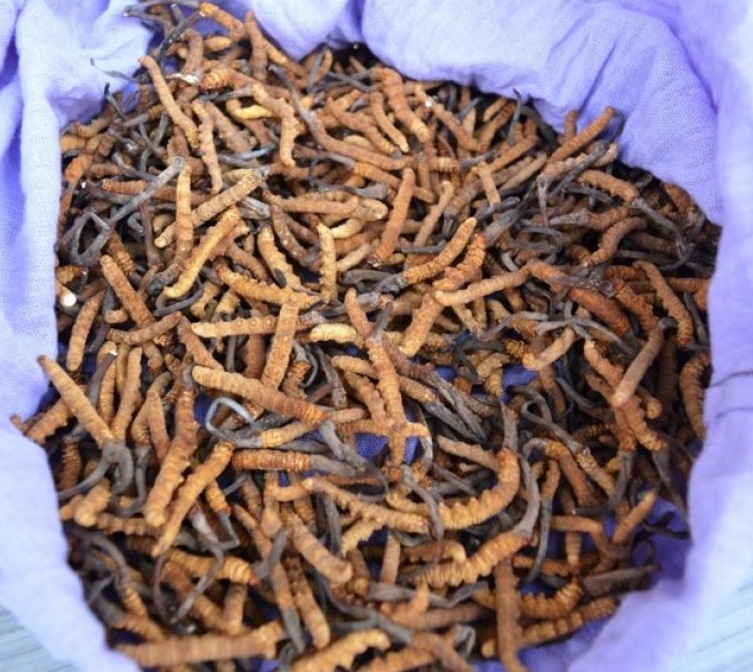Himalayan Gold
- In the Himalayas, the reliance of local communities on the trade and collection of Himalayan Gold, caterpillar fungus has become extremely popular in recent decades.
- Caterpillar fungus (Ophiocordyceps Sinensis) is a fungal parasite of larvae (caterpillars) that belongs to the ghost moth.
- It has been used in traditional Tibetan and Chinese medicine as a tonic, as a therapeutic medicine for lung, liver and kidney problems.
- In the recent times, it has widely traded as an aphrodisiac (stimulating sexual desire) and a powerful tonic, often called the ‘Himalayan Viagra’.
- It is endemic to the Tibetan Plateau, including the adjoining high Himalaya (3,200-4,500 metres above sea level).
- It is locally known as Kira Jari (in India), Yartsagunbu (in Tibet) and Yarsagumba (in Nepal).
- It has been found in alphine meadows of Nanda Devi Biosphere Reserve, Askot Wildlife Sanctuary, Kanchendzonga Biosphere Reserve and Dehan-Debang Biosphere Reserve.
- The harvesting of fungus starts at the beginning of May and lasts till the end of June.
- It depends on factors such as weather, snow cover on the pasture and elevation of collection sites.
- TRAFFIC, the wildlife trade monitoring network reported that the illegal trading of it is also a significant issue

TRAFFIC
- TRAFFIC, the wildlife trade monitoring network, is a leading non-governmental organisation working globally on trade in wild animals and plants.
- It is a strategic alliance of IUCN and World Wide Fund for Nature (WWF).
- Its mission is to ensure that trade in wild plants and animals is not a threat to the conservation of nature.
- It plays a vital role in tackling illegal wildlife trade through conducting research and analysis, advocacy and awareness work and by supporting remedial action against illegal wildlife trade.
CHEOPS Satellite
- CHEOPS – CHaracterising ExOplanet Satellite is a new telescope going to be launched by European Space Agency.
- Unlike, NASA’s Kepler and TESS mission, it is a follow-up mission for the study of exoplanets rather than a discovery machine.
- Thus, it will help in determining planet sizes and other information.
- It will lift-off as a secondary passenger on a Soyuz-Fregat rocket.
- Its aim is to measure size of known transiting exoplanets and search for transits of exoplanets previously discovered via radial velocity.
- It is the first mission dedicated to searching for exoplanetary transits by performing ultra-high precision photometry on bright stars already known to host planets.
- The Mission objectives are,
- Use ultra-high precision photometry to measure accurate sizes of a large sample of Earth to Neptune sized planets,
- Seeks to measure light curves of hot Jupiters to see how energy is transported in planetary atmospheres,
- Combine CHEOPS size measurements with existing planet masses to constrain their composition and internal structures.
- Identify prime targets to search for the fingerprints of key molecules in the planets’ atmospheres using future observatories on Earth.
Cyclones in Jupiter
- NASA's Juno probe was launched in 2016 to reveal the story of Jupiter’s formation and evolution.
- When Juno first arrived in Jupiter, it discovered giant cyclones encircling the planet’s poles (9 in the north and 6 in the south).
- Each is nearly as wide as the continental US.
- It was discovered using data from Jovian Infrared Auroral Mapper (JIRAM) instrument.
- It has recently discovered a new cyclone on Jupiter’s South pole on its 22nd flyby of the planet. Now the South Pole has 7 cyclones.
Click here to know more about Juno
Tansen Samaroh
- It is a popular classical music festival in Madhya Pradesh.
- It is a five-day festival celebrated every year in the memory of one of the most eminent singers of Indian history, ‘Mian Tansen’.
- It begins with traditional style in Gwalior with the recitations of Harikatha and Milad.
- It is organised by Ustad Alauddin Khan Kala Evam Sangeet Academy, under the Madhya Pradesh culture department.
- Noted vocalist Pandit Vidyadhar Vyas will be presented the National Tansen Award for 2019 which is given to outstanding exponents of Hindustani classical music.
- Tansen was one of the nine gems in the court of one of the greatest Mughal rulers of India, Emperor Akbar.
Source: PIB, The Indian Express
